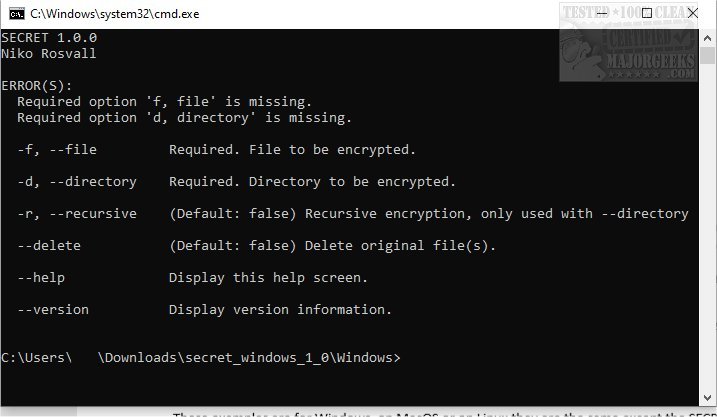Secret is an easy-to-use multi-platform command-line encryption tool.
Secret is an easy-to-use multi-platform command-line encryption tool.
Secret makes use as easy as possible since it comes as a standalone binary file that doesn't require installation, all you need to do is copy the file to some path and run it directly from there.
Secret is capable of handling the encryption of even large files, and it supports all file types. Secret will also permit you to encrypt entire directories with ease, even recursively.
Secret includes a built-in help function available by utilizing the following command: SECRET.exe –help.
Below you will find examples for use:
File encryption:
SECRET.exe encrypt -f"/path/to/some/file.txt" –delete
This example would encrypt file.txt, rename it to file.txt.secret and after the encryption delete the original file (file.txt)
File decryption:
SECRET.exe decrypt -f ”/path/to/some/file.txt.secret” –delete
This example would decrypt file.txt.secret, rename it to file.txt and after the encryption delete the original encrypted file (file.txt.secret)
Directory encryption:
SECRET.exe encrypt -d ”/path/to/some/test-dir” --recursive
This example shows encrypting directory test-dir with –recursive flag. So all directories under test-dir will be encrypted too. How Secret works is that it goes through all the files in the directory and encrypting them one by one. Without –delete flag Secret will leave original files intact, useful for testing, and for cases where you do want to keep the original files too.
Decrypting a directory would work the same way, but using decrypt instead of the encrypt subcommand.
Similar:
Video: How to Add Encrypting File System (EFS) to the Right-Click Context Menu
How to Add 'Open Command Window Here' Context Menu
How to Disable the Command Prompt in Windows 10
The Ultimate List of Every Known Command Prompt and PowerShell Commands
PowerShell and Command Prompt 101
Download


